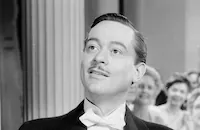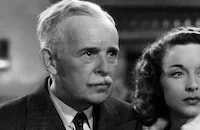The Man with Two Faces

Brief Synopsis
Cast & Crew
Archie Mayo
Edward G. Robinson
Mary Astor
Ricardo Cortez
Mae Clarke
Louis Calhern
Film Details
Technical Specs

Synopsis
After recovering from a nervous breakdown, Jessica Wells makes her return to the stage by appearing in The Dark Tower , which is produced by her lover, Ben Weston. The play, which also stars her brother, Damon Wells, is a big hit out of town and Ben is ready to open it in New York. He convinces Damon to continue on in his role and the whole family is ready to celebrate when Stanley Vance, Jessica's former husband who is presumed dead, arrives at the house. Jessica's breakdown occurred after Vance abandoned her. Vance had a hypnotic hold over her that only ended when she heard of his death. Now the family learns that he is not dead, but is ready to re-establish his hold on Jessica and her money. Jessica immediately falls under his spell again and acquiesces to all his demands. Vance is eager for the play to open, and when Damon points out that Jessica is too much of a zombie to act when she is around him, Vance asks for money to leave her alone. Later a man calling himself Jules Chautard visits Vance to request rights to the play. Scenting money, Vance is eager to meet Chautard in his hotel room. Chautard offers Vance a drink, which contains a narcotic, and when he passes out, Chautard stabs him. Chautard checks out of the hotel and travels quickly to Ben's office, where he reveals himself to be Damon. The police search the hotel room, finding nothing but some false hair in the Bible. The police question Damon and when one of them, Curtis, learns that he is an actor, he grows suspicious. When the play finally opens on Broadway, there are still no clues to the identity of the murderer. The case is about to be declared closed when Curtis visits Damon in his dressing room. He tells Damon that they learned that Vance murdered his first wife and also stole money from another woman. He then adds that he once saw Damon in a play, fifteen years ago, playing the Duc de Rastignac, the model for Chautard, and shows him the mustache they found in the hotel. After Damon admits he killed Vance, Curtis suggests that because Vance was a murderer and thief, Damon will get a light sentence.

Director

Archie Mayo
Cast

Edward G. Robinson

Mary Astor

Ricardo Cortez

Mae Clarke

Louis Calhern

Arthur Byron

John Eldredge

David Landau
Emily Fitzroy

Henry O'neill
Anton Stengel
Arthur Aylesworth
Margaret Dale
Virginia Sale

Dorothy Tree
Mary Russell
Mrs. Wilfrid North

Howard Hickman
Maude Turner Gordon
Dick Winslow
Frank Darien
Bert Moorhouse
Ray Cooke
Jack Mchugh
Douglas Cosgrove
Wade Boteler
Guy Usher
Milton Kibbee

Joseph Crehan
Crew

Videos
Movie Clip


Trailer
Film Details
Technical Specs

Articles
The Man With Two Faces
Of course, credit also has to go to the authors of the Broadway play on which the film was based, George S. Kaufman and Alexander Woollcott, two of the great wits of their time and charter members of the famous Algonquin Round Table. Their original, The Dark Tower, ran on stage for only 57 performances between November 1933 and January 1934, but their names alone carried enough clout to get their property picked up by Warner Bros. (under the banner of subsidiary First National Pictures). Prior to release, the film was known by its stage title, as well as "The Strange Case of Mr. Chautard" and "Dark Victory." Fortunately, the latter name was passed over and reserved for the acclaimed 1939 Bette Davis melodrama that earned her a fourth (out of 11) Academy Award nomination.
Robinson's thespian sister is played by Mary Astor, who harbored a rather dark secret during production of this picture that would explode into national headlines just a couple of years later. As The Dark Tower was closing on Broadway, the married Astor was beginning a torrid affair with Kaufman, also married but well known as "Public Lover Number One" for his numerous dalliances with some of the most desirable women in show business. Astor and her husband divorced in 1935; a year later, during a custody battle, he threatened to make public her diary, which reputedly made many breathless, salacious references to her sex life with the playwright. The diary was never admitted as evidence, but it became a hot topic of conversation. Although the scandal had great potential to derail her career, Astor emerged unscathed. In fact, it gave her a professional boost. As for Kaufman, well, it didn't hurt his reputation any, either as author or lover.
Also appearing in the cast were Ricardo Cortez, who had originated the role of Sam Spade in the first version of Dashiell Hammett's The Maltese Falcon (1931), in which Astor would memorably appear when it was remade in 1941. The aristocratic Louis Calhern (Duck Soup, 1933; The Asphalt Jungle, 1950) played Astor's Svengali-like husband, and Mae Clarke was also on hand, grateful not to be taking another grapefruit in the face, as she had in The Public Enemy (1931), courtesy of James Cagney.
The look of the film was greatly enhanced by award-winning cinematographer Tony Gaudio, a longtime Warners asset who shot seven films with Edward G. Robinson, including Little Caesar.
The biggest praise for the film, however, went to the studio's decision to refashion the play (and change its ending) under the deft hand of screenwriters Tom Reed and Niven Busch. As the New York Times put it, "There may be reasons for doubting the excellence of the original work, but only a diehard will deny that the motion picture has performed an effective translation." The paper also noted that Astor "pines away so heartily...as to cause some alarm for her health." History does not record if she drew on any aspect of her private life for this performance.
The play was used very loosely as the basis for a Warners B movie a few years later, The Dark Tower (1943).
Director: Archie Mayo
Producer: Robert Lord (uncredited)
Screenplay: Tom Reed, Niven Busch, from the play The Dark Tower by George S. Kaufman and Alexander Woollcott
Cinematography: Tony Gaudio
Editing: William Holmes
Art Direction: John Hughes
Cast: Edward G. Robinson (Damon Welles), Mary Astor (Jessica), Ricardo Cortez (Weston), Mae Clarke (Daphne), Louis Calhern (Stanley Vance)
By Rob Nixon

The Man With Two Faces
Quotes
Trivia
The original play opened in New York City, New York, USA on 25 November 1933 and had 57 performances. Anton Stengel and Margaret Dale originated their movie roles in the play, and the cast included Porter Hall and Margaret Hamilton.
Dorothy Tree (Patsy Dowling) and Frank Darien (Doorman) are in studio records for those roles, but were not seen in the film.
Notes
Before release the film was variously entitled The Strange Case of Mr. Chautard, Dark Victory and The Dark Tower.















